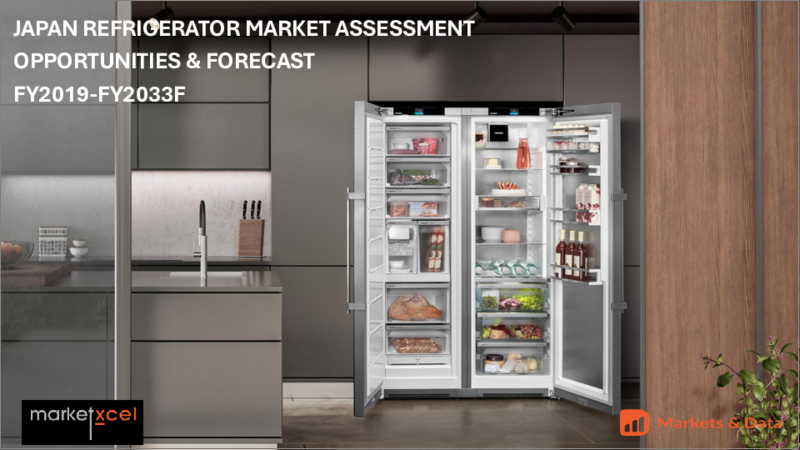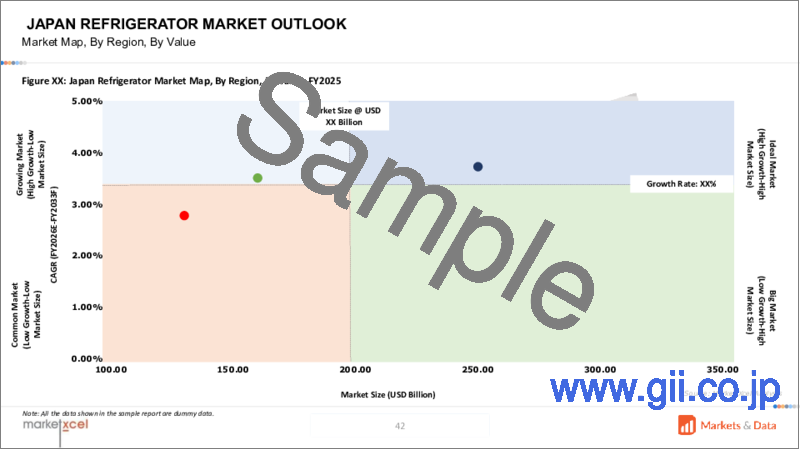|
|
市場調査レポート
商品コード
1673667
日本の冷蔵庫市場:製品タイプ別、タイプ別、展開タイプ別、容量別、最終用途別、技術別、価格別、流通チャネル別、地域別、機会、予測、2018年~2032年Japan Refrigerator Market Assessment, By Product Type, By Type, By Deployment Type, By Capacity, By End-use, By Technology, By Price, By Distribution Channel, Region, Opportunities and Forecast, FY2018-FY2032F |
||||||
カスタマイズ可能
|
|||||||
| 日本の冷蔵庫市場:製品タイプ別、タイプ別、展開タイプ別、容量別、最終用途別、技術別、価格別、流通チャネル別、地域別、機会、予測、2018年~2032年 |
|
出版日: 2025年03月10日
発行: Markets & Data
ページ情報: 英文 125 Pages
納期: 3~5営業日
|
- 全表示
- 概要
- 図表
- 目次
日本の冷蔵庫の市場規模は、予測期間(2025年~2032年)に3.50%のCAGRで拡大し、2024年の18億4,000万米ドルから2032年には24億2,000万米ドルに成長すると予測されています。日本の冷蔵庫市場は、技術革新、消費者のライフスタイルの変化、エネルギー効率意識の高まりによって拡大しています。家電技術革新の国である日本では、AI冷却、IoTによるインターネット接続、より優れたエネルギー効率といった新機能を備えたインテリジェント冷蔵庫への需要が高まっています。こうした進歩はすべて、利便性と環境への優しさを選ぼうとする技術革新的消費者を惹きつけてきました。
都市化と家族の人数の減少が、小型でスペース効率の良い冷蔵庫の需要を押し上げています。さらに、現代社会における多忙なライフスタイルは、より優れた食品保存性と利便性を備えた高性能家電製品に対する需要を高めています。その結果、メーカーは進化する消費者の需要に応えるため、ミニマリスト・デザイン、マルチドア・デザイン、冷却技術の改良に注力しています。
さらに、政府やその他の当局がエネルギー効率の高い電化製品の普及を促しており、グリーン冷媒や高効率製品を奨励する規制も市場をさらに牽引しています。顧客は電気代を節約し、二酸化炭素排出量を減らすため、省エネ家電を選ぶ傾向が強まっています。
eコマースサイトの成長も冷蔵庫市場の成長を後押ししています。オンライン・ショッピングが普及し、日本の消費者は冷蔵庫の豊富なモデルを手頃な価格で入手できるようになり、宅配によって購入プロセスが容易になっています。
当レポートでは、日本の冷蔵庫市場について調査し、市場の概要とともに、製品タイプ別、タイプ別、展開タイプ別、容量別、最終用途別、技術別、価格別、流通チャネル別、地域別動向、および市場に参入する企業のプロファイルなどを提供しています。
目次
第1章 プロジェクトの範囲と定義
第2章 調査手法
第3章 エグゼクティブサマリー
第4章 お客様の声
第5章 日本冷蔵庫市場の見通し、2018年~2032年
- 市場規模の分析と予測
- 市場シェア分析と予測
- 市場マップ分析、2024年
- 製品タイプ別
- タイプ別
- 展開タイプ別
- 容量別
- 最終用途別
- 技術別
- 価格別
- 流通チャネル別
- 地域別
第6章 需要供給分析
第7章 輸出入の分析
第8章 バリューチェーン分析
第9章 ポーターのファイブフォース分析
第10章 PESTLE分析
第11章 価格分析
第12章 市場力学
第13章 消費者購買行動分析
第14章 市場の動向と発展
第15章 政策と規制状況
第16章 ケーススタディ
第17章 競合情勢
- 市場リーダートップ5の競合マトリックス
- 参入企業トップ5のSWOT分析
- 市場の主要企業トップ10の情勢
- Hitachi, Ltd.
- Panasonic Corporation
- Toshiba Corporation
- Mitsubishi Electric Corporation
- Sharp Corporation
- Fujitsu General Limited
- Haier Japan Sales Co., Ltd.
- Hisense Japan Co., Ltd.
- IRIS Ohyama Inc.
- Yamazen Corporation
第18章 戦略的提言
第19章 調査会社について・免責事項
List of Tables
- Table 1. Competition Matrix of Top 5 Market Leaders
- Table 2. Mergers & Acquisitions/ Joint Ventures (If Applicable)
- Table 3. About Us - Regions and Countries Where We Have Executed Client Projects
List of Figures
- Figure 1. Japan Refrigerator Market, By Value, In USD Billion, FY2018-FY2032F
- Figure 2. Japan Refrigerator Market, By Volume, In Thousand Units, FY2018-FY2032F
- Figure 3. Japan Refrigerator Market Share (%), By Product Type, FY2018-FY2032F
- Figure 4. Japan Refrigerator Market Share (%), By Type, FY2018-FY2032F
- Figure 5. Japan Refrigerator Market Share (%), By Deployment Type, FY2018-FY2032F
- Figure 6. Japan Refrigerator Market Share (%), By Capacity, FY2018-FY2032F
- Figure 7. Japan Refrigerator Market Share (%), By End-use, FY2018-FY2032F
- Figure 8. Japan Refrigerator Market Share (%), By Technology, FY2018-FY2032F
- Figure 9. Japan Refrigerator Market Share (%), By Price, FY2018-FY2032F
- Figure 10. Japan Refrigerator Market Share (%), By Distribution Channel, FY2018-FY2032F
- Figure 11. Japan Refrigerator Market Share (%), By Region, FY2018-FY2032F
- Figure 12. By Product Type Map-Market Size (USD Billion) & Growth Rate (%), FY2024
- Figure 13. By Type Map-Market Size (USD Billion) & Growth Rate (%), FY2024
- Figure 14. By Deployment Type Map-Market Size (USD Billion) & Growth Rate (%), FY2024
- Figure 15. By Capacity Map-Market Size (USD Billion) & Growth Rate (%), FY2024
- Figure 16. By End-use Map-Market Size (USD Billion) & Growth Rate (%), FY2024
- Figure 17. By Technology Map-Market Size (USD Billion) & Growth Rate (%), FY2024
- Figure 18. By Price Map-Market Size (USD Billion) & Growth Rate (%), FY2024
- Figure 19. By Distribution Channel Map-Market Size (USD Billion) & Growth Rate (%), FY2024
- Figure 20. By Region Map-Market Size (USD Billion) & Growth Rate (%), FY2024
Japan refrigerator market is projected to witness a CAGR of 3.50% during the forecast period FY2025-FY2032, growing from USD 1.84 billion in FY2024 to USD 2.42 billion in FY2032. Japan's refrigerator market is expanding due to technology innovation, changing consumer lifestyles, and increased energy efficiency awareness. Japan as a nation of home appliance innovation has seen mounting demand for intelligent refrigerators with new features such as AI-cooled cooling, internet connectivity through IoT and better energy efficiency. All these advances have attracted the technology-innovating consumer who would want to choose convenience and eco-friendliness.
Urbanization and shrinking family sizes have pushed demand for smaller and space-efficient refrigerator designs. In addition, a busy lifestyle in the modern world has increased demand for high-performance appliances with better food preservation and convenience. As a result, manufacturers are focusing on minimalist designs, multi-door designs, and improved cooling technologies to meet evolving consumer demands.
Additionally, the government and other authorities are urging energy efficient appliances, which has also driven the market further with regulations encouraging green refrigerants and high-efficiency products. Customers are now more likely to choose energy saving appliances to save on electricity bills and decrease their carbon footprint.
In addition, the growth of e-commerce websites has also driven the growth of the refrigerator market. With online shopping becoming more popular, Japanese consumers can have access to extensive models of refrigerators, affordable prices, and home delivery has made the buying process easier.
For instance, in December 2024, Hoshizaki Corporation completed its switch to natural refrigerants for all its standard commercial refrigerators, freezers and refrigerator-freezers in the Japanese market. This transition entailed introducing 364 new models. With these natural refrigerants the global warming potential will be reduced compared to conventional hydrofluorocarbons (HFCs).
Advancement in Technology and Innovation is Driving the Market Expansion
The technological advancements and innovation are key drivers of refrigerator demand in Japan, a market known for its high consumer expectations and emphasis on efficiency. Japanese manufacturers are continuously integrating cutting-edge technologies to enhance performance, energy efficiency, and convenience, which makes refrigerators an essential part of modern households.
One of the most significant trends is the rise of smart refrigerators equipped with AI-powered cooling systems and IoT connectivity. These models allow users to monitor and adjust temperature settings remotely via smartphone apps, which optimize cooling based on foot storage and receive maintenance alerts. Such features align with Japan's tech-savvy consumers who value automation and energy conservation.
Moreover, energy efficiency is another major focus which is driven by both government regulations and consumer awareness. Brands like Panasonic and Sharp are introducing inverter technology and eco-friendly refrigerants that reduce electricity consumption while maintaining optimal cooling performance. With Japan's push toward sustainability, refrigerators with low global warming potential (GWP) refrigerants like R-600a and R-290 are gaining popularity. It diversifies the market's revenue streams and assures consistent demand, considerably contributing to its growth.
For instance, in July 2024, Hitachi Corporation launched its Made in Japan refrigerators, which are designed for consumers who want high-end appliances with premium features, ample storage and sleek design. The Hitachi 735 Multi Drawer French Door Fridge is equipped with innovative technologies such as sensor cooling, vacuum insulated panel, and frost recycling cooling.
Urbanization and Lifestyle Changes are Fueling Market Growth
Urbanization and evolving lifestyle preferences have fueled the expansion of the Japan refrigerator market. As more individuals move to urban cities, the demand for efficient and compact home appliances has grown. Since available living space is limited in the city, Japanese consumers opt for space-saving, multifunctional refrigerators that can easily blend into contemporary apartment designs. Manufacturers have responded by designing slim, multi-door, and built-in refrigerators that optimize storage without compromising performance.
A busy lifestyle has also contributed to changing food consumption patterns. With an increasing number of dual-income households, there is a greater reliance on meal prepping, frozen foods and convenience cooking which requires refrigerators with better storage, longer freshness retention and specialized compartments for different food types. Features like vacuum-sealed compartments, advanced humidity control, and inverter cooling technology help to keep food fresh for extended periods, which reduces food wastage and caters to health-conscious consumers.
Moreover, Japan's aging population has influenced demand for refrigerators with user-friendly designs, easy-access compartments, and smart technology that allows remote monitoring, IoT-enabled refrigerators which notify users about expiration dates and allow temperature adjustments via smartphone app are becoming increasingly popular.
For instance, in May 2023, Hoshizaki Corporation announced the launch of 68 models of natural refrigerant based refrigerators and freezers in the value price range. These models are designed to be compact, which will cater to urban consumers with limited kitchen space.
Top Freezer Segment is Leading the Market Share
The top freezer refrigerator segment has cemented its dominance with strong statistics in the market. Due to its space efficiency, affordability, and alignment with consumer preferences. In Japan, where urban living spaces are often compact, top freezer refrigerators offer a practical solution by providing sufficient storage without occupying excessive floor space. Their design is well-suited to the smaller kitchens commonly found in Japanese households, which make a top freezer a preferred choice for consumers who are seeking functionality within limited areas.
Affordability is another major factor driving the dominance of top freezer models. Top freezer models are more cost-effective and appeal to budget-conscious consumers. Japan's aging population and a high number of single-person households have raised the demand for compact, energy-efficient, and reasonably priced appliances, which remains high.
Additionally, Japanese consumers prioritize energy efficiency and durability when purchasing appliances. Top freezer refrigerators are known for their efficient cooling technologies, which aligns with Japan's focus on sustainability and energy conservation.
Moreover, the cultural preference for fresh ingredients and frequent grocery shopping reduces the need for oversized refrigerators. Since Japanese consumers shop daily or every few days, they prefer refrigerators that optimize fresh food storage rather than extensive freezing capacity.
Central Region Dominates Refrigeration Market Share
The central region is exerting its dominance in the Japan refrigeration market. Due to its high population density, strong economic activity, and evolving consumer preferences. As the most populous region, Kanto includes major cities such as Tokyo, Yokohama, and Saitama where millions of households require modern home appliances including refrigerators. The high concentration of urban dwellers' demand for compact, energy-efficient refrigerators that suit smaller living spaces, which makes the region a key market for appliance manufacturers.
Moreover, economically, Kanto is Japan's financial and commercial hub, home to numerous multinational corporations, retail centers, and high-income consumers. The presence of a large working-class population, and an expatriate community influences purchasing behavior with a growing preference for high-tech, energy-efficient, and smart refrigerators. Consumers in this region are more inclined to invest in premium appliances with advanced features such as inverter technology, AI-based cooling and multi-door designs, which contribute to higher sales of mid to high-end models.
In addition, lifestyle has becomes very important in Kanto's leadership in the refrigerator market. The urban lifestyle of high speed promotes frequent grocery shopping, leading to demand for refrigerators that have been optimized for fresh food storage. Moreover, Kanto's expanding e-commerce infrastructure and retail networks facilitate shopping by consumers from a large number of refrigerator models further fueling sales. The confluence of variables solidifies the region's leadership position.
Future Market Scenario (FY2025 - FY2032F)
With increasing digitalization, Japanese consumers are expected to shift toward AI-powered and IoT-enabled refrigerators that offer remote control, inventory tracking, and energy optimization.
As urban households seek convenience and better organization, the demand for multi-door and French door refrigerators will rise especially among affluent consumers in metropolitan areas like Tokyo and Yokohama.
Stricter government regulations and growing environmental awareness will push manufacturers to develop refrigerators with advanced inverter technology and eco-friendly refrigerants to reduce power consumption, which will likely boost the demand.
Key Players Landscape and Outlook
Continuous innovation characterizes the landscape of the refrigerator market in Japan, as the companies compete to outperform one another in terms of energy efficiency and sustainability and compact designs for urban spaces. The market prognosis remains positive, owing to advancement in technology and innovation, and urbanization and lifestyle changes. Refrigerator manufacturers in Japan are focused on innovation and technology, and energy efficiency, which will likely define the industry's future. Collaborations and developing technologies are projected to increase competition in this fast-paced market.
Table of Contents
1. Project Scope and Definitions
2. Research Methodology
3. Executive Summary
4. Voice of Customers
- 4.1. Respondent Demographics
- 4.2. Brand Awareness
- 4.3. Factors Considered in Purchase Decisions
- 4.4. Preferred Purchase Channel
- 4.5. Frequency of Purchase
- 4.6. Challenges Faced Post Purchase
5. Japan Refrigerator Market Outlook, FY2018-FY2032F
- 5.1. Market Size Analysis & Forecast
- 5.1.1. By Value
- 5.1.2. By Volume
- 5.2. Market Share Analysis & Forecast
- 5.2.1. By Product Type
- 5.2.1.1. Single Door
- 5.2.1.2. Top Freezer
- 5.2.1.3. French Door
- 5.2.1.4. Bottom Freezer
- 5.2.1.5. Side-By-Side
- 5.2.1.6. Others
- 5.2.2. By Type
- 5.2.2.1. Smart
- 5.2.2.2. Non-Smart
- 5.2.3. By Deployment Type
- 5.2.3.1. Free-Standing Refrigerators
- 5.2.3.2. Built-In Refrigerators
- 5.2.4. By Capacity
- 5.2.4.1. Less Than 200 L
- 5.2.4.2. 200 L - 400 L
- 5.2.4.3. Above 400 L
- 5.2.5. By End-use
- 5.2.5.1. Residential
- 5.2.5.2. Commercial
- 5.2.6. By Technology
- 5.2.6.1. Inverter
- 5.2.6.2. Non-Inverter
- 5.2.7. By Price
- 5.2.7.1. Mass
- 5.2.7.2. Premium
- 5.2.7.3. Luxury
- 5.2.8. By Distribution Channel
- 5.2.8.1. Supermarkets and Hypermarkets
- 5.2.8.2. Exclusive Stores
- 5.2.8.3. Multi-branded Stores
- 5.2.8.4. Online
- 5.2.8.5. Others
- 5.2.9. By Region
- 5.2.9.1. North
- 5.2.9.2. Central
- 5.2.9.3. South
- 5.2.10. By Company Market Share Analysis (Top 5 Companies and Others - By Value, FY2024)
- 5.2.1. By Product Type
- 5.3. Market Map Analysis, FY2024
- 5.3.1. By Product Type
- 5.3.2. By Type
- 5.3.3. By Deployment Type
- 5.3.4. By Capacity
- 5.3.5. By End-use
- 5.3.6. By Technology
- 5.3.7. By Price
- 5.3.8. By Distribution Channel
- 5.3.9. By Region
6. Demand Supply Analysis
7. Import and Export Analysis
8. Value Chain Analysis
9. Porter's Five Forces Analysis
10. PESTLE Analysis
11. Pricing Analysis
12. Market Dynamics
- 12.1. Market Drivers
- 12.2. Market Challenges
13. Consumer Buying Behavior Analysis
14. Market Trends and Developments
15. Policy and Regulatory Landscape
16. Case Studies
17. Competitive Landscape
- 17.1. Competition Matrix of Top 5 Market Leaders
- 17.2. SWOT Analysis for Top 5 Players
- 17.3. Key Players Landscape for Top 10 Market Players
- 17.3.1. Hitachi, Ltd.
- 17.3.1.1. Company Details
- 17.3.1.2. Key Management Personnel
- 17.3.1.3. Key Products Offered
- 17.3.1.4. Key Financials (As Reported)
- 17.3.1.5. Key Market Focus and Geographical Presence
- 17.3.1.6. Recent Developments/Collaborations/Partnerships/Mergers and Acquisition
- 17.3.2. Panasonic Corporation
- 17.3.3. Toshiba Corporation
- 17.3.4. Mitsubishi Electric Corporation
- 17.3.5. Sharp Corporation
- 17.3.6. Fujitsu General Limited
- 17.3.7. Haier Japan Sales Co., Ltd.
- 17.3.8. Hisense Japan Co., Ltd.
- 17.3.9. IRIS Ohyama Inc.
- 17.3.10. Yamazen Corporation
- 17.3.1. Hitachi, Ltd.
Companies mentioned above DO NOT hold any order as per market share and can be changed as per information available during research work.






